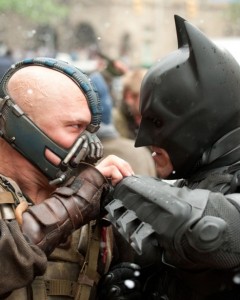The Dark Knight Rises
Posted on July 18, 2012 at 11:38 am
 There’s a reason you never hear about “your friendly neighborhood Batman.” Spidey may have some angst and guilt and abandonment issues but he is downright sunny-natured compared to the brooding soul of Bruce Wayne (Christian Bale), holed up in Wayne Manor with only his loyal manservant Alfred (Michael Caine) and his tortured memories. At the end of the second chapter of director and co-writer Christopher Nolan’s Dark Knight trilogy, Wayne decided it would be better for the citizens of Gotham to believe that Harvey Dent (Aaron Eckhart) died a hero than to tell them to truth about the descent of a once-honorable man into madness and vigilantism. So everyone thinks that Batman is the villain who killed Dent instead of the hero who saved the city and Wayne is refusing to see anyone.
There’s a reason you never hear about “your friendly neighborhood Batman.” Spidey may have some angst and guilt and abandonment issues but he is downright sunny-natured compared to the brooding soul of Bruce Wayne (Christian Bale), holed up in Wayne Manor with only his loyal manservant Alfred (Michael Caine) and his tortured memories. At the end of the second chapter of director and co-writer Christopher Nolan’s Dark Knight trilogy, Wayne decided it would be better for the citizens of Gotham to believe that Harvey Dent (Aaron Eckhart) died a hero than to tell them to truth about the descent of a once-honorable man into madness and vigilantism. So everyone thinks that Batman is the villain who killed Dent instead of the hero who saved the city and Wayne is refusing to see anyone.
In Dent’s memory, legislation has been passed to keep dangerous criminals imprisoned and the crime rate is down so low that a policeman jokes they may be reduced to chasing people down for overdue library books. But everyone in this story is tortured by secrets and shame, even Commissioner Gordon (Gary Oldham), who carries in his breast pocket a speech setting the record straight but does not have the nerve to deliver it. There is the lissome but light-fingered catering assistant who turns out to be the notorious Selina Kyle (Anne Hathaway, rocking the leather catsuit). And there is Bane (Tom Hardy), a terrorist who shows his contempt for humanity by cynically couching his atrocities in the idealistic vocabulary of social justice, trashing spirits as he trashes the concrete and social structures of the community.
It is overlong at two hours and 40 minutes but the action scenes are superbly staged, from the audacious plane-to-plane maneuver at the very beginning to the literally earthshaking attack on the city. The “pod” motorcycle chases are sensational, especially with Hathaway at the helm. She is never referred to as Catwoman, by the way, but when her goggles are up on her head, they amusingly evoke cat’s ears. Joseph Gordon-Levitt is a standout as a perceptive young detective who understands Wayne too well. Hardy does his best to overcome the daunting limitations of the masked role, acting with his eyes and body language, but the weirdly disembodied voice is unconnected to the action and at times seems like a bad dub job in a cheesy karate film. Bale’s performance in this role (or, I should say, these roles) has always seemed thin to me, but fellow Oscar-winners Marion Cotillard, Morgan Freeman, and Michael Caine add some heft, especially Caine’s devoted Alfred, and it is good to see Tom Conti and Juno Temple in small but important roles.
The “Dark Knight Rises” title applies equally to both hero and villain in this story. This is like a chess game where all the pieces are black. Everyone has masks. Everyone has scars and a soul corrupted by a bitter stew of anger, fear, betrayal, abandonment, and isolation. Wayne says more than once he wears a mask to protect those he cares about, but he wears it to keep himself from getting too close to them, too. Nolan continues his exploration of duality and untrustworthy narrators (though one logical inconsistency inadvertently telegraphs a plot twist). Even the WMD at the heart of the action was originally designed for a benign, even heroic, purpose. This is a thoughtful, ambitious story that explores the metaphor and heightened reality of the superhero genre to illuminate the fears and secrets — and potential for heroism and yearning for a clean slate — we all share.
Parents should know that this film has extended comic book-style action, peril, and violence, many characters injured and killed, torture, hostages, references to sad loss of parents, brief mild language, non-explicit sexual situation
Family discussion: Almost everyone in this movie has secrets and conflicts — how many can you identify? Was Bruce Wayne right in thinking the risks of the energy technology were greater than the benefits? How are Bane and Batman alike?
If you like this, try: the Frank Miller “Dark Knight” comic books and the other “Dark Knight” movies
